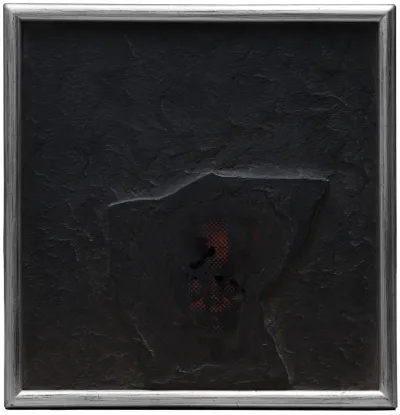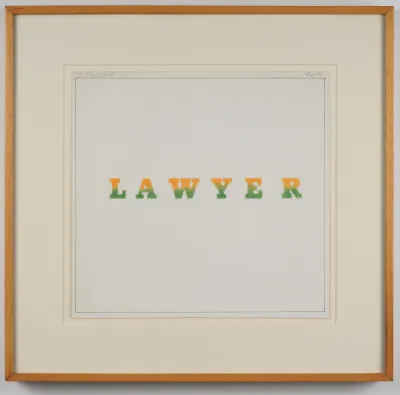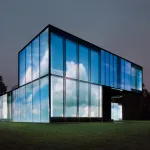
For nearly 50 years, Joan Agajanian Quinn has asked the questions that everyone wants to answer. A consummate journalist, she was the West Coast editor at Interview magazine, a society editor at the LA Herald Examiner, and host of the TV interview shows Joan Quinn etc, The Joan Quinn Profiles, and Beverly Hills View. When I first asked her for an interview, she demurred with a simple “I don’t have anything to say.” For Quinn, the focus should always be on the artists whose careers she and her late husband, Jack Quinn, have supported for decades.
In the ’50s, she became friendly with artist Billy Al Bengston, when they were both working at the department store Desmond’s. “He was a catalyst to [meeting] all those guys,” Quinn said of the Los Angeles circle he would introduce her to, including Ed Ruscha, Ken Price, Ed Moses, Laddie John Dill, Charles Arnoldi, Robert Graham, and Larry Bell, who hosted a party at his Market Street studio in Venice Beach that Quinn attended early on. “They became friends—it was really all about friendship,” she said.
From the start, the Quinns supported artists beyond just buying their work, helping to cover their rent or pay for a traffic ticket. (Jack was a top attorney.) Toward the end of the ’60s, their Beverly Hills home became the epicenter of one of LA’s many arts communities. Joan would host salons—a mix of artists and Jack’s legal connections—in the main living room, where we spoke over afternoon tea and almond cookies. Frequent guests over the years included David Hockney, Divine, and Andy Warhol.
Many people describe Quinn, who radiates positive energy and has an infectious smile, as the doyenne of LA’s art scene. But she prefers to consider herself a connector. “That’s why I think I was put here,” she said. “That’s my forte, and I do it every day still.”
Beyond her collecting, Quinn, now in her late 80s, has been essential to supporting artists. For 16 years, beginning in 1981, she was the longest-serving member of the California Arts Council, a public art grant-making agency to which she was appointed by Willie Brown, then the speaker of the California State Assembly. She also served on the Beverly Hills Arts & Culture Commission for about a decade. Among the artists she helped were Claire Falkenstein, Betye Saar, Carlos Almaraz, and Elsa Flores.
“I learned that you don’t know anything,” she said of her time working within the complexities and challenges that surround public art. “There’s so much to know—and you think you know a lot about art because you know artists—but you don’t know anything.”

Quinn’s father, J.C. Agajanian, came from a background in rubbish collection to become a race-car owner and racing promoter; a fixture at the Indianapolis 500, his drivers won in 1952 and 1963. Growing up in LA in an Armenian family unconcerned with art, Quinn was first drawn to the subject by Dora De Larios, whom she befriended in middle school. De Larios later became a renowned ceramicist whose sculptures Quinn collected.
Quinn met her husband, Jack, while she was working as an assistant registrar at the University of Southern California law school. (She also worked as a schoolteacher at the time, which she continued to do until the early years of their marriage.) She invited him over for dinner one night, offering to cook him a steak. He accepted the invitation but said he couldn’t eat meat that evening, given that it was a Friday and he was Catholic. After further consideration, he changed course and said he could wait until midnight to have the steak.

Quinn came to know many of her artist friends by being at the right place at the right time. She once spotted David Hockney at Harrods during a trip to London, and was formally introduced to him at a party soon after. She became part of Warhol’s inner circle in a similar way: they had been at the same party in New York, and the next day, while she and Jack were shopping for vintage Cartier watches, she saw Warhol pull up in a Rolls Royce. She knew that Warhol, a formidable watch collector, would be interested in what they were buying, so she went out to speak with him while Jack finalized the sale.
“We just started talking and became friends after that,” she said. “We built up a relationship. We went shopping together all the time on Madison Avenue.” On a trip to LA in the late ’70s, Warhol, after asking for jewelry store recommendations in Beverly Hills, offered her the job of West Coast editor at Interview. She told Warhol, whom she often accompanied to church, that she didn’t have any editorial experience aside from writing for her high school paper and USC’s Daily Trojan. But Warhol persisted, and she agreed.

When I visited Quinn in her Beverly Hills home over the summer, her rapport with artists still thrummed with signs of such exchanges, despite several of her most iconic pieces being on loan to the Laguna Art Museum (LAM) for a third such showing of the collection. There was still plenty of art to see, including a few works that are immovable. Projecting from the wall above where Quinn sat was a blimp-like silver-leaf sculpture, Queen Crest (1976), from Bryan Hunt’s “Airships” series. (Quinn isn’t afraid it will collapse since it’s constructed of balsa wood, making it as light as a roll of paper towels.) Nearby was a pair of doors designed by Tony Berlant, with a colorful rendering of the Quinn house on one side and a portrait of the couple—Joan as a whirlwind, Jack as a rooted tree—on the other.
The Quinns often invited artists to pick out a spot in their home in which to install their work, and that’s where it would stay. As Jack once explained to critic and journalist Martin Filler: “The only way to live with things you love is to continue to keep them around even when you run out of wall space, or as has happened here, floor space.” (Jack also displayed some of the collection in his Downtown LA law office, where it remains on loan.)

Several canvases and framed pieces were stacked against each other on the floor near the house’s entrance, including a painting of fish by Roberto Gil de Montes and a newer acquisition by Ramon Ramirez, a semiabstract painting with a powerline that Quinn said evokes “the feeling of what I was wearing” when she met the artist. On Quinn’s iconic spiral staircase hung the painting smocks of Bengston, Moses, and Dill, a sculpture of a female nude by Anthony Donaldson suspended above them. There were also art books galore piled high, and objects in other categories that Quinn has collected: Armenian rugs, Tiffany glass, and Victorian taxidermy birds. Not on view were her deep holdings of vintage watches and jewelry (especially that by Seaman Schepps and Jean Schlumberger, who worked for Tiffany & Co.).
Elsewhere in her home were a table filled with a variety of Robert Graham’s female nude sculptures, a box by Larry Bell, a vitrine with several ceramic works by Ken Price, and pieces by Joe Goode, Frank Gehry, Richard Bernstein, Sam Francis, and Yolanda González, among others. “They speak to each other,” Quinn said of the works on view. “It’s like a community.”

The 2024 Laguna show, titled “On the Edge,” featured some 100 works, about one-tenth of a collection that never hued to market trends and that embraced artists of color long before it was fashionable. “I think Jack would have been very surprised that they [were] in a museum,” Quinn said of those works. “That’s what [they’re] for, to share.”
The works in the show, which closed in September, are emblematic of the Quinns’ eclectic taste. Frank Gehry’s Table & Chair (1970), in curvilinear carved cardboard, shares a room with a John Valadez painting and a dense Almaraz rendering of Echo Park in pastel on paper. A grid of four Ruscha gas station prints is not far from a mixed-media collage by Daniel LaRue Johnson and three watercolors by Edward Kienholz, whose titles—$375.00, $376.00, and $377.00—not so slyly indicate their value. A collaborative work by Gary Gilbar, Jackie Dubey, and Manny Silverman shows cutouts of about two dozen artists in the couple’s circle, under the title Artist Box, A Gift to Joan and Jack (1983).

From Bengston’s famed “Dentos” series, a double portrait from 1967 of the couple’s twin daughters, Amanda and Jennifer, displayed family intimacy. The artist gave them to Quinn a month after the children’s birth. Another Ruscha, in ink and pastel, shows the word LAWYER, referencing Jack’s profession.

And then there are portraits of Quinn. For almost as long as she’s been collecting, artists have asked her to sit for them—and the collection now includes some 300 works in nearly every medium, capturing different sides of Quinn. The Laguna exhibition included two new portraits, and Yolanda González painted a third in the galleries. The most unexpected one sat in a corner, glowing: comprising various hues of argon, it represents the colors that Dill saw when looking at her, Quinn said, adding, “each portrait shows the artist’s personality.”
Jack once sold a Bruce Nauman piece without asking Joan, and they vowed never to do it again. But, after Jack’s death in 2017, at age 84, Joan had to make an exception. To cover hefty inheritance taxes, she turned to Ruscha’s Hurting the Word Radio #2 (1964), which the couple bought from the artist and displayed across from their bedroom for decades. (Their version had clamps on the titular R and O, as opposed to the more famous #1 [only on the O], now owned by the Menil Collection in Houston.) Hurting the Word Radio #2 sold at Christie’s in 2019 for $52.5 million, reportedly to Jeff Bezos, breaking the artist’s previous record by more than $20 million. Quinn was devastated and called Ruscha to inform him. “He said, ‘That’s OK—don’t worry about it. You took care of it for 40 years,’” she recalled, adding that she wished she could take care of it for another 40.
“It’s been so a part of our being, I don’t know any different,” Quinn said of her many decades as a collector and connoisseur. “I feel lucky to have lived in a creative time. It opened my eyes; it opened me up. I’m happy that I was a part of it. I feel like I was a part of something—part of a community.”
A version of this article appears in the 2024 ARTnews Top 200 Collectors issue.


